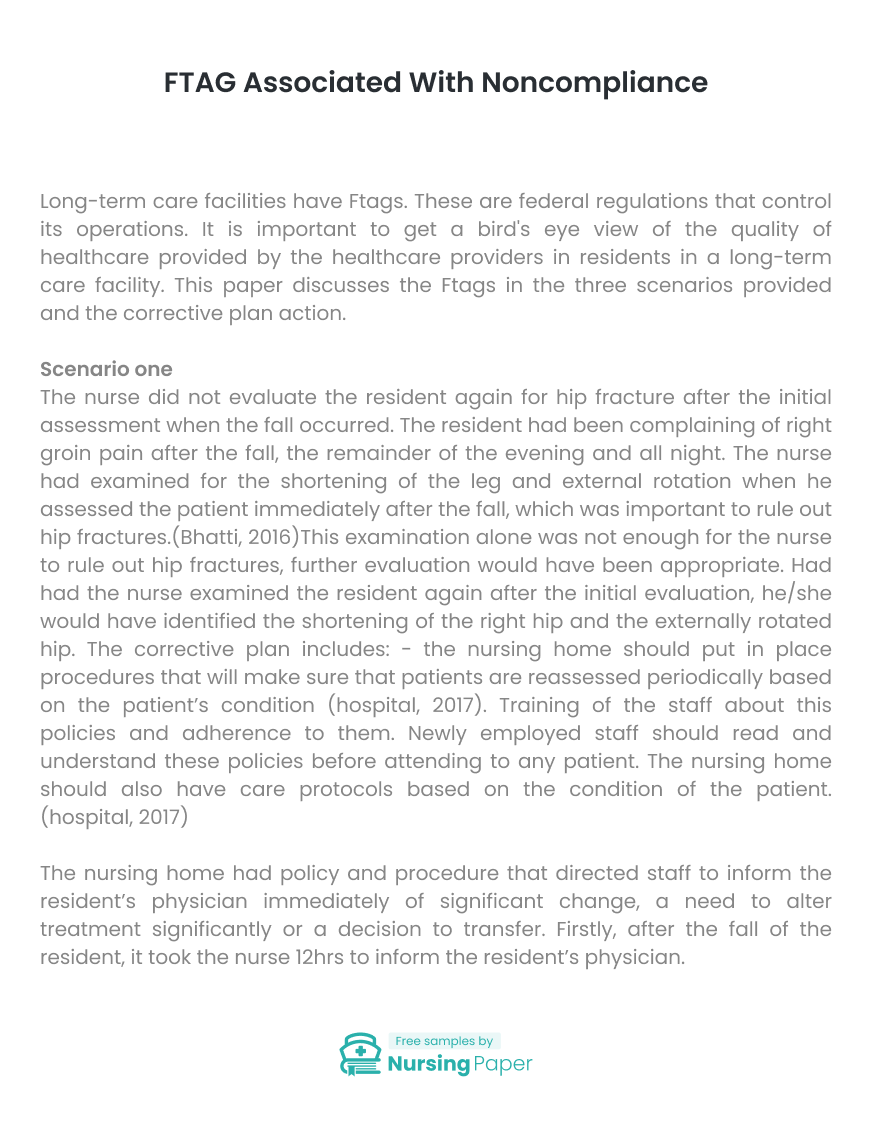
FTAG Associated With Noncompliance
Long-term care facilities have Ftags. These are federal regulations that control its operations. It is important to get a bird’s eye view of the quality of healthcare provided by the healthcare providers in residents in a long-term care facility. This paper discusses the Ftags in the three scenarios provided and the corrective plan action.
Scenario one
The nurse did not evaluate the resident again for hip fracture after the initial assessment when the fall occurred. The resident had been complaining of right groin pain after the fall, the remainder of the evening and all night. The nurse had examined for the shortening of the leg and external rotation when he assessed the patient immediately after the fall, which was important to rule out hip fractures.(Bhatti, 2016)This examination alone was not enough for the nurse to rule out hip fractures, further evaluation would have been appropriate. Had the nurse examined the resident again after the initial evaluation, he/she would have identified the shortening of the right hip and the externally rotated hip. The corrective plan includes: – the nursing home should put in place procedures that will make sure that patients are reassessed periodically based on the patient’s condition (hospital, 2017). Training of the staff about this policies and adherence to them. Newly employed staff should read and understand these policies before attending to any patient. The nursing home should also have care protocols based on the condition of the patient.(hospital, 2017)


The nursing home had policy and procedure that directed staff to inform the resident’s physician immediately of significant change, a need to alter treatment significantly or a decision to transfer. Firstly, after the fall of the resident, it took the nurse 12hrs to inform the resident’s physician. This was wrong since the policy required the nurse to inform the physician immediately. Secondly, the resident was sent by ambulance to the emergency room at the regional medical center. This was against the policy of the nursing homes because the resident’s physician was not informed of this transfer. The staff should face the appropriate disciplinary measures to ensure that they follow the nursing home’s policy and procedure. (hospital, 2017)
Two other residents had fallen with concerns of evaluation of falls and the interventions. The nursing homes should have written policies and procedures on the evaluation of the patients. Protocols on patient’s intervention should be made available for easy referral by the health care providers.(hospital, 2017)
Scenario 2
After the fall of the second resident, there was no documentation to support the assessment done and new intervention attempted. In medicine, if there is no documentation, it is as if it didn’t happen. Documentation is important because it conveys information among the healthcare providers, enhances research, to evaluate the patient’s response to treatment and prognosis of the disease. In this case, documentation was missing (Keystone, 2009). The corrective action plan includes training of health care providers on documentation and importance of documentation.(coles, 2011)

Scenario 3
There was also no documentation of the assessment of fall and the possible change in intervention noted that might reduce the risks of future falls of the third resident. Documentation is as important as the assessment itself. If documentation does not take place, there would be no evidence that assessment was done. Failure to document the interventions that might have reduced future risks of falls makes it hard for the healthcare providers to know the future management and prognosis to prevent future falls.
Conclusion
The long-term care facilities should ensure strict adherence to policies and procedures outlined by the management. This would ensure quality healthcare to its residents.
1. Bhatti, N.S. (2016, February 28). medscape. Retrieved from hip fracture in emergency medicine: https://emedicine.mescape.com
2. Coles, l. (2011, March 31). AAPC. Retrieved from Corrective action plan: https://www.aapc.cm
3. Hospital, c. l. (2017). calhoun liberty hospital. Retrieved from Calhoun liberty hospital releases corrective action plan: www.calhounlibertyhospital.com
4. Keystone, c. (2009, January). crozier keystone health system. Retrieved from documentation- how important is it?: www.crozerkeystone.org/healthcareb



The download will start shortly.

The download will start shortly.
 Subject:
Nursing
Subject:
Nursing  Number of pages: 4
Number of pages: 4  Subject:
Health and Social Care
Subject:
Health and Social Care  Number of pages: 7
Number of pages: 7  Subject:
Health and Social Care
Subject:
Health and Social Care  Number of pages: 2
Number of pages: 2  Subject:
Nursing
Subject:
Nursing  Number of pages: 4
Number of pages: 4  Subject:
Health and Social Care
Subject:
Health and Social Care  Number of pages: 2
Number of pages: 2  Subject:
Health and Social Care
Subject:
Health and Social Care  Number of pages: 6
Number of pages: 6  Subject:
Nursing
Subject:
Nursing  Number of pages: 5
Number of pages: 5  Subject:
Health and Social Care
Subject:
Health and Social Care  Number of pages: 3
Number of pages: 3  Subject:
Nursing
Subject:
Nursing  Number of pages: 5
Number of pages: 5  Subject:
Medicine
Subject:
Medicine  Number of pages: 2
Number of pages: 2  Subject:
Health and Social Care
Subject:
Health and Social Care  Number of pages: 2
Number of pages: 2  Subject:
Medicine
Subject:
Medicine  Number of pages: 5
Number of pages: 5  Subject:
Health and Social Care
Subject:
Health and Social Care  Number of pages: 4
Number of pages: 4  Subject:
Health and Social Care
Subject:
Health and Social Care  Number of pages: 2
Number of pages: 2  Subject:
Health and Social Care
Subject:
Health and Social Care  Number of pages: 8
Number of pages: 8 
